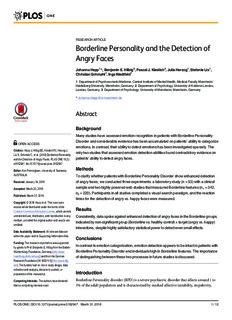
Borderline Personality and the Detection of Angry Faces PDF
Preview Borderline Personality and the Detection of Angry Faces
RESEARCHARTICLE Borderline Personality and the Detection of Angry Faces JohannaHepp1*,BenjaminE.Hilbig2,PascalJ.Kieslich3,JuliaHerzog1,StefanieLis1, ChristianSchmahl1,IngaNiedtfeld1 1 DepartmentofPsychosomaticMedicine,CentralInstituteofMentalHealth,MedicalFacultyMannheim/ HeidelbergUniversity,Mannheim,Germany,2 DepartmentofPsychology,UniversityofKoblenz-Landau, Landau,Germany,3 DepartmentofPsychology,UniversityofMannheim,Mannheim,Germany *[email protected] Abstract Background ManystudieshaveassessedemotionrecognitioninpatientswithBorderlinePersonality Disorderandconsiderableevidencehasbeenaccumulatedonpatients’abilitytocategorize OPENACCESS emotions.Incontrast,theirabilitytodetectemotionshasbeeninvestigatedsparsely.The Citation:HeppJ,HilbigBE,KieslichPJ,HerzogJ, onlytwostudiesthatassessedemotiondetectionabilitiesfoundcontradictoryevidenceon LisS,SchmahlC,etal.(2016)BorderlinePersonality andtheDetectionofAngryFaces.PLoSONE11(3): patients’abilitytodetectangryfaces. e0152947.doi:10.1371/journal.pone.0152947 Methods Editor:KimFelmingham,UniversityofTasmania, AUSTRALIA ToclarifywhetherpatientswithBorderlinePersonalityDisordershowenhanceddetection Received:January14,2016 ofangryfaces,weconductedthreeexperiments:alaboratorystudy(n=53)withaclinical sampleandtwohighlypoweredwebstudiesthatmeasuredBorderlinefeatures(n =342, Accepted:March20,2016 1 n =220).Participantsinallstudiescompletedavisualsearchparadigm,andthereaction Published:March31,2016 2 timesforthedetectionofangryvs.happyfacesweremeasured. Copyright:©2016Heppetal.Thisisanopen accessarticledistributedunderthetermsofthe Results CreativeCommonsAttributionLicense,whichpermits unrestricteduse,distribution,andreproductioninany Consistently,dataspokeagainstenhanceddetectionofangryfacesintheBorderlinegroups, medium,providedtheoriginalauthorandsourceare indicatedbynon-significantgroup(Borderlinevs.healthycontrol)×target(angryvs.happy) credited. interactions,despitehighlysatisfactorystatisticalpowertodetectevensmalleffects. DataAvailabilityStatement:Allrelevantdataare withinthepaperanditsSupportingInformationfiles. Conclusions Funding:Theresearchreportedonwassupported Incontrasttoemotioncategorization,emotiondetectionappearstobeintactinpatientswith bygrantstoProf.BenjaminE.HilbigfromtheBaden- WürttembergFoundation,Germany(http://www. BorderlinePersonalityDisorderandindividualshighinBorderlinefeatures.Theimportance bwstiftung.de/forschung/)andfromtheGerman ofdistinguishingbetweenthesetwoprocessesinfuturestudiesisdiscussed. ResearchFoundation[HI1600/1-1](http://www.dfg. de/).Thefundershadnoroleinstudydesign,data collectionandanalysis,decisiontopublish,or Introduction preparationofthemanuscript. BorderlinePersonalitydisorder(BPD)isaseverepsychiatricdisorderthataffectsaround1to CompetingInterests:Theauthorshavedeclared thatnocompetinginterestsexist. 3%oftheadultpopulationandischaracterizedbymarkedaffectiveinstability,impulsivity, PLOSONE|DOI:10.1371/journal.pone.0152947 March31,2016 1/12 AngerDetectioninBPD andinterpersonalproblems[1,2].Dysfunctionalemotionprocessingisconsideredoneofthe centralfactorsthatcontributetothephenomenologyofthisdisorder.Asafirststepintheemo- tionprocessingcontinuum,thequestionofhowwellBPDpatientscanrecognizeemotionsin othershasgainedparticularinterestinthepast[3].Numerousstudiesonemotionrecognition inBPDhavebeenconductedandfinallysummarizedintwocomprehensiveliteraturereviews [4,5]aswellastworecentmeta-analyses[6,7].Wearguethatthestudiessummarizedtherein actuallycapturetwodistinctaspectsofemotionrecognition,namelyemotioncategorization andemotiondetection,andpresentnewevidenceontherelativelyunder-researchedaspectof emotiondetection. Accordingtoarecentseriesofexperiments,emotioncategorizationanddetectionaredis- tinctprocessesthatrequiredistinctabilitiesandshouldthusbediscriminatedfromeachother [8].Emotioncategorizationrequirestheabilitytocorrectlyidentifyandverballylabelapre- sentedemotion.InpreviousstudiesonBPDsamples,thisabilitywasmeasuredbyaskingpar- ticipantstoindicatewhichemotiontheysawinafacebychoosingthecorrecttermfromaset ofpre-definedansweringoptions.Ameta-analysisonthesestudiesrevealedanemotioncate- gorizationdeficitacrossallemotionsandselectivedeficitsfordifferentiatingbetweendisgust andanger[5]. Incontrast,emotiondetectiondoesnotrequirespecificemotionstobenamedanddistin- guishedfromoneanother;itsimplycomprisestheabilitytoaccuratelyperceivewhetherany emotionalcontentispresentinafaceornot.Emotiondetectionhaspreviouslybeencaptured usingmorphingparadigmsinwhichaninitiallyneutralfacegraduallychangesintoanemo- tionalone.Theearlieststageinthemorphingprocessatwhichparticipantsperceivesome degreeofemotionintheface(andthereforestoppedthemorphingprocess)thusindicates theiremotiondetectionabilities.EvidenceonBPDpatients’performanceinthistaskwas mixed.Twostudiesfoundnodifferenceregardingemotiondetectionbetweenhealthycontrols (HC)andBPDpatients[9]oryouthwithBPDsymptoms[10].Othersfoundsuperior[11]and stillothersfoundinferior[12]emotiondetectionperformanceintheincludedBPDgroups. Finally,highBPDsymptomcountspredictedalowerdetectionthresholdforangrymalefaces inanon-patientsample[13].Evidently,clearconclusionsregardingBPDpatients’emotion detectionabilitiesarenotpossiblebasedonthisbodyofwork.Onepotentialproblemwith morphingstudiesisthattheyassessnotonlyemotiondetectionbutalsoanadditionalelement ofemotioncategorization,because,oncethemorphingprocessisstopped,participantsstill havetolabelthedisplayedemotion.TogainabetterunderstandingofBPDpatients’emotion detectionabilitiesitthusseemsnecessarytoassessdetectioninparadigmsthatdonotalso includecategorization. Sofar,onlytwostudieshaveaddressedemotiondetectionoutsideofmorphingstudies.The firststudybySchulzeandcolleaguesusedarapid,continuousstreamofstimuliconsistingof facialphotographsthatwerecroppedintoastandardovalshape[14].Severaltrialsincludeda happyorangryface,whereasothersincludedonlyneutrallookingfaces.Aftereachtrial,partic- ipantsindicatedwhetheranemotionalfacewaspresentornot.Nomaineffectofgroupwas found,butBPDpatientswereselectivelymoresensitivetowardsangrystimuli,producing greaterhitratesforangryfacesthantheHCgroup.AsecondstudybyHagenhoffandcol- leagues[15]assessedemotiondetectionabilitiesforhappyandangryfacesusingtheface-in- the-crowd-paradigm[16].Inthisparadigm,emotionalfaceshavetobedetectedin“crowds” (i.e.matrices)ofneutralfaces.Inthepast,theface-in-the-crowdparadigmhasrepeatedly revealedanangersuperiorityeffect(ASE):angryfacesinneutralcrowdsweredetectedfaster andwithfewererrorsthanhappyfacesinneutralcrowds[17].Hagenhoffandcolleagues employedlinedrawingsofroundfaces(“smileyfaces”)andanalyzedthereactiontimeswith whichparticipantswereabletodetectangryfaces.Theyfoundnooverallgroupdifferencebut PLOSONE|DOI:10.1371/journal.pone.0152947 March31,2016 2/12 AngerDetectioninBPD alsonodetectionadvantageforangryfacesintheBPDgroup,whichstandsincontrasttothe previousfindingsbySchulzeandcolleagues. Insum,whilethereisconsiderablepreviousevidenceonemotioncategorizationinBPD[6, 7],evidenceonemotiondetectionissparse.Moreover,theonlytwoexistingstudiesthathave usedparadigmsthatassessemotiondetectiondirectlyfoundcontradictingevidenceforthe angrycondition[14,15].Schulzeandcolleaguesfoundanincreasedsensitivityforangryfaces whileHagenhoffandcolleaguesfoundnospecificadvantageforangryfaces.Asaresultofthis, itremainsentirelyunclearwhetherpatients’detectionabilitiesareinfactaltered,particularly forangryfaces,andfurtherstudiesareclearlyneededtoresolvethis. Inanefforttoshedfurtherlightonthistopicweconductedadetection-onlystudy.Inline withtheprocedureofthetwopreviousdetectionstudies,wefocusedonhappyandangrysti- muli.Specifically,wechosetouseaface-in-the-crowd-paradigmsimilartotheoneHagenhoff andcolleaguesused.WepreferredthisparadigmtotheoneemployedbySchulzeandcol- leaguesbecauseitisamoreimmediatemeasureofemotiondetection:intheface-in-the-crowd paradigmparticipantsrespondimmediatelytoadetectedface,whereasintheotherparadigm participantsindicatewhethertheyhavedetectedanemotionalfacewithdelay,attheendofa picturesequence.Fortheface-in-the-crowdparadigm,weintendedtoimproveuponprevious materialbycreatinganewsetofgeometricallycontrolledfacialstimulithatwouldminimize confoundingvisualeffects:whenhappystimuliaredrawnsuchthateyebrowsandmouthare paralleltothefacialsurround,thiscancausegreatersensitivityfortheangryfacessimply becausethesearemoresalient[18].Inlinewithpreviousstudiesusingtheface-in-the-crowd paradigm,weexpectedthat(1)BPDandHCparticipantswouldallshowanASEregarding reactiontimes,thusdetectingangryfacesfasterthanhappyfaces.Additionallyweassessed whetherusinggeometricallycontrolledstimuli(2)BPDpatientswouldshowanangerdetec- tionadvantageintheformofastrongerASEintheface-in-the-crowdparadigm,mirroringthe onepreviouslyfoundbySchulzeandcolleagues. MethodsStudy1 Participants Twenty-ninefemaleBPDpatientsand28femaleHCswererecruitedbetweenMay2011and December2011.PatientswererecruitedthroughapatientdatabaseattheCentralInstituteof MentalHealth,Mannheim,Germany,andhealthycontrolparticipantswererecruitedthrough advertisementsinlocalnewspapersAfterapplyingacriterionforaminimalusabletrialnum- berof90%percondition,twenty-sevenparticipantsremainedintheBPDgroupand26partici- pantscomprisedthecontrolgroup.BPDpatientswerediagnosedbyanexperiencedclinician usingtheGermanversionofthestructuredclinicalinterviewfortheDSM-IV[19]andthe InternationalPersonalityDisorderExamination[20].Generalexclusioncriteriawerecomorbid diagnosesofschizophrenia,bipolardisorder,developmentaldisorder,orsubstancedepen- dency.Themajorityofpatientswereunmedicated(61.5%);severaltookantidepressants (19.2%),neuroleptics(7.7%),oracombinationofboth(11.5%).Patientshadonaverage1.9 comorbiddisorders(SD=1.5),whichincludedmainlyanxietydisorders(n=19),mooddisor- ders(n=12),eatingdisorders(n=4),otherpersonalitydisorders(n=3),andeachonecaseof paindisorder,alcoholabuse,andtrichotillomania.Patientsmeanscoreof2.05(SD=0.84)on theBorderline-Symptom-List,indicatedsymptomseveritysimilartothatobservedinother patientsamples[21].Patientsfurtherhadameanscoreof27.48(SD=10.14)ontheBeck- Depression-Inventory[22],indicatingclinicallyrelevantdepressivesymptoms.Controls’mean scoreof0.37ontheBorderline-Symptom-List(SD=0.41)and5.27(SD=5.22)ontheBeck- Depression-InventoryindicatedtheabsenceofclinicallyrelevantBPDanddepressive PLOSONE|DOI:10.1371/journal.pone.0152947 March31,2016 3/12 AngerDetectioninBPD Fig1.Exemplaryface-in-the-crowdmatrixwithangrytargetforstudies1/2(left)andstudy3(right). doi:10.1371/journal.pone.0152947.g001 symptoms.Further,HCfulfillednocriteriaforanypresentorpastmentaldisorder.Patients (aged18to42,M=26.63,SD=6.15)werematchedtoHC(aged18to38,M=25.19, SD=5.43)forageandlevelofeducation. Material Intheface-in-the-crowdparadigm,eachtrailconsistedofa3×3matrixoffaceswhichfollowed a1000msinter-trail-interval.Participantswereinstructedtoindicateasfastandaccuratelyas possiblewhetheratargetfacewaspresentinthematrix(pressA=“targetpresent”,pressL= “targetabsent”).Targetfacesincludedahappy,angryandabluebaselinestimulus.Stimuli wereschematicfacesdesignedusingthevectordrawingprogramInkscape[23].Importantly, angryandhappystimuliweregeometricallycontrolledvariantsoftheneutralface:Theireye- browsandmouthwereexactmirrorimagesofeachother.Thus,ingeometricalterms,theydif- feredfromtheneutralfacetoexactlythesameextent.Parallelismofeyebrowsandfacial surroundwasminimizedbyincludinghair.Thebluestimulus,whichservedasaneutralbase- line,wasanexactcopyoftheneutralstimulus,butwithblueeyebrowsandmouth.Anexem- plarymatrixwiththestimuliincludedhereispresentedinFig1. Procedure ThestudywasreviewedandethicsapprovalwasgrantedbytheethicscommitteeoftheUni- versityofHeidelbergbeforethestudybegan(committeename:MedizinischeEthik-Kommis- sionIIderMedizinischenFakultätMannheimderUniversitätHeidelberg).Atthebeginningof thestudyallparticipantsprovidedinformedwrittenconsentafterobtainingdetailed PLOSONE|DOI:10.1371/journal.pone.0152947 March31,2016 4/12 AngerDetectioninBPD informationaboutthestudyprocedure.Theethicscommitteeapprovedofthisprocedure. Capacitytoconsentwasdeterminedbythepatient’sdiagnosticianandwasgivenforallpartici- pants.Next,participantsprovideddemographicalinformationandthenfilledinseveralques- tionnairesnotpertinenttothecurrentinvestigation.Next,participantscompletedfourpractice trialsoftheface-in-the-crowdparadigm,followedbyasetof216experimentaltrials,consisting of108noisetrials(notarget)and36targettrialsforeachtypeoftarget(angry/happy/blue). ResultsStudy1 ThedatasetforStudy1canbeaccessedinS1Dataset.Reactiontimes(inms)werelog-trans- formedduetonon-normality.Extremeoutlierswithareactiontimemorethan2.5SDabove thesamplemeanwereexcluded(1.2%oftrials).Allstatisticalanalyseswereconductedforcor- rectlyansweredtrialsonly(M=93.6%ofalltrials,SD=14.0%).Allmeans,standarddeviations andconfidenceintervalsarepresentedseparatelyforbothgroupsinTable1.Datawasanalyzed usingarepeatedmeasuresANOVAwithreactiontimesasthedependentvariable(see Table2). Hypothesis1:Ashypothesized,theASEwaspresentforbothgroups,indicatedbyasignifi- cantmaineffectoftargettype(seeTable2).Post-hoct-testsconfirmedtheexpectedorderof means:angryfacesweredetectedsignificantlyfasterthanhappyfaces,t(52)=-10.04,p<.001, d=-1.38,95%CI[-1.76,-0.99],andbluefaces,t(52)=-5.68,p<.001,d=-0.78,95%CI [-1.09,-0.46]. Hypothesis2:Contrarytothishypothesis,BPDpatientsdidnotshowastrongerASEthan HCs,indicatedbyanon-significantgroup×targetinteraction(seeFig2).Notethatallresult patternsremainedunchangedwhenrepeatinganalyses(i)withoutthebluecondition,(ii) whendummy-codingforparticipants’medicationstatus,(iii)whenusingnon-transformed reactiontimes,and(iv)whenusinghitratesasthedependentvariable. DiscussionStudy1 Thenon-significantgroup×targetinteractionpointstoanequallystrongASEforbothBPD patientsandHCs.Thisisinlinewithapreviousstudyemployingthesameparadigmbutdif- ferentstimuli[15]andspeaksagainstenhancedemotiondetectionforangryfacesinBPD. However,uponcloseinspectionthisfindingcannotbetakenasconclusiveevidencethatthere Table1. Means(M),standarddeviations(SD),and95%confidenceintervals(95%CI)ofthemean(log-transformed)reactiontimesinallstudies, presentedforthedifferenttargettypesintheBorderlinePersonalityDisordergroup(BPD)andhealthycontrolgroup(HC). HC BPD target M(SD) 95%CI M(SD) 95%CI Study1 angry 3.04(0.09) [3.03,3.06] 3.04(0.07) [3.03,3.06] happy 3.10(0.07) [3.08,3.11] 3.10(0.08) [3.08,3.11] blue 3.09(0.08) [3.07,3.10] 3.08(0.07) [3.06,3.10] Study2 angry 3.01(0.08) [3.00,3.02] 3.04(0.08) [3.02,3.05] happy 3.06(0.09) [3.05,3.07] 3.08(0.08) [3.07,3.09] blue 3.05(0.10) [3.04,3.06] 3.09(0.12) [3.07,3.10] Study3 angry 3.12(0.08) [3.11,3.13] 3.14(0.08) [3.13,3.15] happy 3.15(0.07) [3.14,3.16] 3.18(0.08) [3.17,3.19] doi:10.1371/journal.pone.0152947.t001 PLOSONE|DOI:10.1371/journal.pone.0152947 March31,2016 5/12 AngerDetectioninBPD Table2. Test-statisticsfortherepeatedmeasuresANOVAmaineffectsoftargettype,groupandtheir interactionforstudies1,2,and3. Study F df p effectsizef[90%CI] Maineffectoftarget(within) Study1 33.45 (1.74,88.52) <.001 0.29[0.21,0.36] Study2 92.94 (1.36,461.65) <.001 0.22[0.18,0.25] Study3 124.72 (1,218) <.001 0.23[0.19,0.27] Maineffectofgroup(between) Study1 0.03 (1,51) .86 0.02[0.00,0.19] Study2 8.70 (1,340) .003 0.15[0.06,0.23] Study3 6.35 (1,218) .012 0.16[0.05,0.27] Interactioneffectofgroup×target Study1 0.16 (1.74,88.52) .85 0.02[0.00,0.06] Study2 2.37 (1.36,461.65) .11 0.04[0.00,0.06] Study3 0.36 (1,218) .55 0.01[0.00,0.05] Note.Degreesoffreedomforstudy1and2areGreenhouse-Geissercorrected. doi:10.1371/journal.pone.0152947.t002 isnosucheffect:Withthegivensampleofn=53,α=.05andβ=.05,theempiricalcorrelation amongrepeatedmeasuresofr=.80,andanon-sphericitycorrectionofε=.87,asensitivity (cid:1) poweranalysisconductedwithg Power[24]indicatedthattheinteractioneffectthatcanbe ruledoutwithinaconventionallevelofstatisticalconfidenceisCohen’sf=0.15(allreportedf valuesinthefollowinganalysesrefertothesquarerootoftheratioofeffectvarianceand (cid:1) pooledwithingroupsvariancesasimplementeding Power3.0).Statedsimply,thisisthe smallesteffectforwhichwehavesufficientpower(1-ß(cid:3).95).Consequently,atrulysmall effectoff=0.10orlessaccordingtoCohen[25]cannotbeexcludedwithsufficientcertainty giventhesamplesize.Thus,wecannotdeterminewhethertherereallywerenodifferencesin emotiondetectionbetweenthegroups,orwhetherwelackedthesamplesizetofindanexisting smalleffect. Consequently,itappearedappropriatetoconductasecondstudywithsufficientstatistical powertodetectevenasmalleffect.Tothisend,werecruitedalargeonline-sampleinwhichwe measuredBPDfeatures,amethodthathasbeensuccessfullyappliedinotherstudiesofBPD [26].Wehypothesizedthat(1)thegeneralASEwouldbereplicatedandsetouttotestwhether, inthismuchlargersample,(2)theASEwouldbestrongerinthegroupwithhighBPDscores thaninthatwithlowscores. MethodsStudy2 Participants Todeterminethenecessarysamplesizeforrulingoutsmalleffects,anaprioripoweranalysis wasconducted.Tomakethisreplicationdirectlycomparabletostudy1,wemaintainedthe analyticalframeworkofarepeatedmeasuresANOVAwithtwogroups.Thenecessarysample sizetodetectasmalleffectoff=0.10,withα=.05and1–β=.95fortheinteractiontermofthe (cid:1) repeatedmeasuresANOVAisn=338.Poweranalysiswasbasedontheg Powerdefaultvalue forthecorrelationamongrepeatedmeasuresofr=.50andaconservativevalueofε=.70. Sinceweexpecteddrop-outandthatsomecaseswouldnotmeettherequirementsforadequate dataquality,weoversampledbyapproximately15%. Three-hundred-and-ninety-oneGermanspeakingparticipantswererecruitedviasocialnet- worksandBPD-relatedwebsitessuchasself-helpgroups.Weensuredthatthefinaldataset PLOSONE|DOI:10.1371/journal.pone.0152947 March31,2016 6/12 AngerDetectioninBPD Fig2.Meanlog-transformedreactiontimes(with95%CI)fortheangry,happyandbluetargetsconditionalongroup:BorderlinePersonality DisorderorhighinBorderlinefeatures(BPD/highBPD)vs.healthycontrolsorlowinBorderlinefeatures(HC/lowBPD). doi:10.1371/journal.pone.0152947.g002 containednorepeatedparticipations(identifiedbyanidenticalIPaddress,sex,andage)and onlyretainedparticipantswhoconfirmedtohaveparticipatedseriously.Afterapplyingfilters foraminimaltrialnumberof90%pertargettype,342participantsremainedinthefinaldata- set.Participantswereaged18to60(M=25.5,SD=6.7),75.7%werefemale,and28.9%ofpar- ticipantswererecruitedfromBPDforumsorBPDself-helpgroups. Material BPDfeatureswereassessedusingtheBorderlinescaleoftheVerhaltens-Erlebens-Inventar (VEI)[27],whichistheGermanadaptationofthePersonalityAssessmentInventory[28].The scaleconsistsof24itemsmeasuringthefacetsidentityproblems,self-harm,negativerelation- ships,andaffectiveinstability,answeredonafourpointLikert-typescale.TheBorderlinescale oftheVEIhasshownagoodinternalconsistencyof.84[27]andvalidityoftheEnglishPAI-- BORhasbeendemonstratedrepeatedly[29,30].Theface-in-the-crowdparadigmwasapplied PLOSONE|DOI:10.1371/journal.pone.0152947 March31,2016 7/12 AngerDetectioninBPD intheexactsamewayasinstudy1.Reactiontimemeasurementusedclient-sideJavaScript whichprovidesmillisecondaccuracy. Procedure Whilecollectingdataonline,wecarefullyfollowedthestandardsforweb-basedexperiments [31].Atthebeginningofthestudyallparticipantsprovidedinformedwrittenconsentafter obtainingdetailedinformationaboutthestudyprocedure.Next,participantscompletedaper- sonalityinventorytheresultsofwhicharereportedelsewhere[32],followedbytheVEI.Next, 210trialsoftheface-in-the-crowdparadigmwerepresented;35foreachtargettype(angry, happy,blue)and105noisetrials.Uponcompletingthistask,participantsansweredseveral controlquestionstoensureseriousparticipation. ResultsStudy2 ThedatasetforStudy2canbeaccessedinS2Dataset.Datawerefilteredandlog-transformed exactlyasinStudy1.Next,agroupwithVEIscoresbelowtheclinicalcut-offscoreof38[28] andonewithparticipantsscoringabovewereformed.Thegroupbelowcut-offcomprised203 participants,theirVEIscoresrangingfrom7to37,M=24.3,SD=7.3,and139participants scoredabovecut-offwithscoresfrom38to69,M=50.1,SD=8.7.TheVEIshowedahigh internalconsistencyofα=.92inthissample. Hypothesis1:TheASEfoundinstudy1wasreplicatedacrossgroups.Again,post-hoct-tests showedangryfacesweredetectedfasterthanhappyfaces,t(341)=-22.1,p<.001,d=-1.20,95% CI[-1.34,-1.05],andbluefaces,t(341)=-9.88,p<.001,d=-0.53,95%CI[-0.65,-0.42]. Hypothesis2:AsinStudy1,themagnitudeoftheASEdidnotdifferbetweengroups(see Table2;Fig2).Notethattheresultpatternsremainedunchangedwhenrepeatinganalyses(i) withoutthebluecondition,(ii)usingnon-transformedreactiontimes,(iii)usingextreme groupsofparticipantswithaVEIscore(cid:4)24(averageratingofmaximal1onallVEIitems)in onegroupandwithascore(cid:3)48intheother(averageratingofminimal2onallVEIitems), (iv)whenusinghitratesasthedependentvariable,(v)inalinearmixedmodelwiththecontin- uousVEIscoreandtargettypeaspredictors. DiscussionStudy2 AsinStudy1,theASEdidnotdifferbetweengroups.However,forthecurrentsample, (cid:1) G Power[24]sensitivityanalysisfortheinteractiontermindicatedthataneffectassmallas f=0.07couldberuledout.Thepoweranalysiswasbasedontheobservedcorrelationamong repeatedmeasuresofr=.74,anon-sphericitycorrectionofε=.68andaconventionallevelof α=.05.Thus,thecurrentsamplesizeimpliedsufficientpowertodetectevensmalleffects. Nonetheless,anull-findingsuchasthepresentoneshouldbeasrigorouslysubjecttoreplica- tionasastudyshowinganeffect.Thus,tofurthertestthepreliminaryconclusionthatthereis nogroup×targetinteraction,wedecidedtoreplicateourownresultsinathirdstudy,using anotherlarge,web-basedsample.Moreover,toensurethatthenullfindingwasnotlimitedto thespecificmaterialweused[18],wecreatedasecondsetofstimulusmaterialwithdifferent identitiesandvaryingemotionalintensities. MethodsStudy3 Participants AnalogoustoStudy2,weperformedanaprioripoweranalysis.Thenecessarysamplesizeto detectasmalleffectoff=0.10with1–β=.95andα=.05wasdeterminedasn=198.Assuming PLOSONE|DOI:10.1371/journal.pone.0152947 March31,2016 8/12 AngerDetectioninBPD acorrelationamongrepeatedmeasuresinasimilarrangeasinStudy1andStudy2(bothr= .75),weadoptedtheslightlymoreconservativevalueofr=.70.Werecruitedparticipantsin thesamefashionasinStudy2andagainoversampledbyapproximately15%.Two-hundred- and-twenty-eightparticipantscompletedtheentirestudy.Allparticipantsprovidedinformed writtenconsentatthebeginningofthestudyandafterhavingobtaineddetailedinformation aboutthestudyprocedure.Afterapplyingthepreviousfilterforaminimaltrialnumber,220 participantsremainedinthefinaldataset.Oftheremainingparticipants(aged18to58, M=28.1,SD=8.6),82.7%werefemale,and35.0%wererecruitedfromBPD-relatedwebsites. ProcedureandMaterial BPDfeatureswereagainassessedusingtheborderlinescaleoftheVEI[27].Thenewmaterial fortheface-in-the-crowdparadigmwascreatedusingInkscape[23].Twelvedifferentidentities (sixfemale,sixmale)wereconstructedinthevariantsangry,happyandneutral.Theintensity oftheemotionalexpression,thatis,thedegreetowhichmouthsandeyebrowswerecurved, wasvaried.Tocreateunsystematicandheterogeneouscrowds,neutralfaceswererandomly selectedfromthestimulussetpertrialandrandomlyassignedtoapositioninthe3×3matrix (seeFig1foranexemplarymatrix).Eachofthe12angry/happytargetfaceswaspresented3 times,alwaysinarandompositioninthematrix,withinacrowdofrandomlyselectedneutral faces.Hence,participantscompleted36targettrialsshowingangry/happyfaceseach.Theblue baselinestimuluswasnolongerincluded,thusparticipantscompleted72noisetrialswithneu- tralmatrices.TheprocedurewasidenticaltothatinStudy2. ResultsStudy3 ThedatasetforStudy3canbeaccessedinS3Dataset. Dataweretransformed,filteredandparticipantsweredividedintotwogroupsexactlyasin Study2,with119participantsscoringaboveand101scoringbelowtheclinicalcut-offofthe VEI.VEIscoresrangedfrom38to68,M=51.5,SD=8.0,inthegroupabovetheclinicalcut- offandfrom5to37,M=24.7,SD=7.9,inthegroupbelowthecut-off.Inthissample,the VEI’sinternalconsistencywasα=.93. Hypothesis1:TheASEwasreplicatedacrossgroups.Post-hoct-testsshowedthatangrysti- muliweredetectedfasterthanhappyones,t(219)=-11.27,p<.001,d=-0.76,95%CI[-0.91,- 0.60].Asinstudy2,theresultpatternsremainedunchangedwhenrepeatinganalyses(i)using non-transformedreactiontimes,(ii)usingextremegroupsofparticipantswithaVEI score(cid:4)24inonegroupandwithascore(cid:3)48intheother,(iii)whenusinghitratesasthe dependentvariable,(iv)inalinearmixedmodelwiththecontinuousVEIscoreandtargettype aspredictors.Hypothesis2:Aspreviously,therewasnosignificantgroup×targetinteraction. (cid:1) G Powersensitivityanalysisfortheinteractiontermindicatedthatinthissampleaneffectas smallasf=0.07couldberuledout.Power-analysisbasedontheempiricalcorrelationamong repeatedmeasuresofr=.81andα=.05. GeneralDiscussion Inalaboratoryexperiment(Study1),wetestedthehypothesisthatBPDpatientsmightdiffer fromHCsindetectingangryfaces,indicatedbyanincreasedASEintheface-in-the-crowdpar- adigm.WedidobserveastrongASE,butitdidnotdifferbetweenBPDpatientsandcontrols. However,aspoweranalysesrevealed,thisfindingwasinconclusiveasitmayhavebeenthe resultofthesmallsamplesizeandthusinherentlylowstatisticalpowertodetectsmalleffects. Hence,weconductedtwofurtherstudieswithlargesamplesandthussufficientpowertorule outevensmalleffects. PLOSONE|DOI:10.1371/journal.pone.0152947 March31,2016 9/12 AngerDetectioninBPD Forstudies2and3,participantswererecruitedonlineandBPDfeaturesweremeasured.Par- ticipantsweredividedintotwogroupsbasedontheclinicalcut-offscore(onegroupwith,one withoutclinicallysignificantBPDfeatures).Itisimportanttonotethat41%ofthesamplein study2and54%ofthesampleinstudy3hadclinicallyrelevantBPDfeaturesabovetheclinical cut-off,duetorecruitmenteffortsintheBPDonlinecommunity.Studies2and3replicatedthe patternobservedinstudy1:ageneralASEwasfound,butnoindicationofagroup×targettype interactionwaspresent,speakingagainstenhancedangerdetectioninBPD.Duetothelarger samplesize,evenasmall(interaction)effectcouldberuledout.Thus,thenullfindingsyieldsup- portforthenullhypothesiswithinaconventionallevelofstatisticalcertainty.Notethatstudy3 replicatedthispatternusingheterogeneousstimuliwithdifferentidentitiesandvaryingemo- tionalintensities.Thefindingisinlinewithapreviousstudythatemployedthesameparadigm [15],yetdifferentstimuli,andstandsincontrasttothefindingbySchulzeandcolleagues[14]. Regardinglimitationsofthestudy,thesamplesofStudies2and3mustbeviewedwithsome caution.AlthoughmeasuringBPDfeaturesintwolargeonlinesamplessolvedtheproblemof insufficientstatisticalpower,theVEI’sclinicalthresholdisofcoursenotequivalenttoaclinical diagnosis,eventhoughtheVEIcut-offisknowntocorrespondverywellwithdiagnosesbased ontheDSM-IV(82%accordance)[29],(73%accordance)[30].Also,theinfluenceofthirdvar- iablessuchascomorbiddiagnoses,substanceabuse,medicationstatusetc.couldnotbecon- trolledforinthewebsamples. Theresultsimplythatitisnecessarytodifferentiatebetweenemotiondetectionandemo- tioncategorizationinBPD.Thefirstrequirestheabilitytoperceivethemerepresenceofan emotion,whereasemotioncategorizationrequiresfurthercognitiveprocessing.Ourexperi- mentsrepeatedlyrevealednodifferencebetweenpatientsandcontrolsforthedetectionof angryfaces,whichsuggeststhatimpairmentsinemotionprocessingmayonlyariselater,when facesareevaluatedandcategorized[6,7].ArecentstudythatmeasuredBPDfeaturesinastu- dentsamplesupportsthenotionofnormalemotiondetectionyetaltered(thatis,greater)emo- tionrecognitionabilities[33]. Ourresultsfurtherhaveimplicationsforclinicalresearch.Itisourviewthatpatient-based, fully-controlledlab-studiesandlarge-scaleweb-studiescouldserveascomplementary approaches.Indeed,mostconclusiveevidencewillnecessarilyentailcompatiblefindingsfrom bothsources.Giventhatsmall-sample,patient-basedstudiesareclearlymorecommoninclini- calresearch,ourrecommendationistocomplementthesewithlarge-scale,web-basedsamples moreoftenandthustestwhethereffects(ornullfindings)holdwhenboththetype-Iandtype- IIerrorarelow. SupportingInformation S1Dataset.Datasetforstudy1. (CSV) S2Dataset.Datasetforstudy2. (CSV) S3Dataset.Datasetforstudy3. (CSV) AuthorContributions Conceivedanddesignedtheexperiments:J.HeppBEHSLIN.Performedtheexperiments:J. HeppBEHJ.HerzogIN.Analyzedthedata:J.HeppPJK.Contributedreagents/materials/anal- ysistools:J.HeppBEHPJKCSIN.Wrotethepaper:J.HeppBEHPJKJ.HerzogSLCSIN. PLOSONE|DOI:10.1371/journal.pone.0152947 March31,2016 10/12
Description: